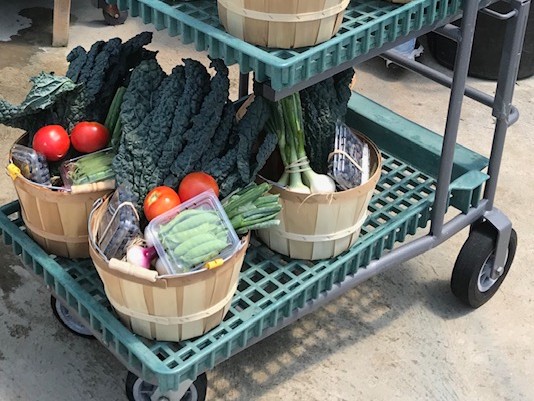
Why You Should Consider a CSA Program
L&GR: When and why did you decide to set up a CSA?
Emily L. Harvey, manager, Harvey’s Farm & Garden Center, Westborough, Massachusetts: We started offering our CSA program in 2014 after realizing there was a demand for one. We had many customers who loved our produce that would ask if we offered one or suggested that we offer one. I remember doing a casual poll in our email newsletter and on Facebook to gauge interest and had an immediate response and wait list so we knew there was an opportunity there.
David Miller, fourth-generation farmer and president of Miller Plant Farm, York, Pennsylvania: The first year of our CSA program was 2012. We opened our new retail garden center in 2011 and then had a facility that was able to handle the customer traffic. Miller Plant Farm is a century farm and had been growing vegetables for many years. The CSA was a way to create cash flow in a normally slow time of year (December-March). 90% of the shares are picked up at the garden center so it guaranteed customer traffic every week on pickup days, which are Tuesdays and Wednesdays. As the spring rush subsides, the CSA extends our plant season also.
Jack Pahl, Pahl’s Market, Apple Valley, Minnesota: Our program has been set up since 2014. We first started seeing demand when there were several programs around the metro around 2010. We weighed our options and decided that this would be a good fit for Pahl Farms. We grow just over 800 acres in produce each year and we figured this program could help us diversify into a little niche market.
You also are getting some cash flow in months where you wouldn’t otherwise because the members pay in advance, and everything costs money such as seed, tilling, harvesting, etc. — that’s a lot of cash going out before any starts coming in.
L&GR: What types of goods do you typically offer in a share?
Harvey: In our CSA program, we offer a seasonal variety of our own, naturally grown fruits, vegetables and herbs.
Miller: We offer a full line of vegetables and fruits. Sweet corn is one of our specialties. Tomatoes, peppers, onions, watermelon, cantaloupe, cucumber, squash, sweet potatoes, white potatoes, beets, green beans, broccoli, cauliflower and more. Peaches, strawberries, plums, apples and even portabella mushrooms. There are also add-ons to the general share — free-range eggs, local Amish-made cheese and our own cut flower bouquet option.
Pahl: That list might be a little too large to fit into one paragraph, but we like to try and aim for about 60 different varieties of fruits and vegetables. Some of your staples are sweet corn, green beans, and bell peppers, and some might be things that people aren’t used to cooking with such as kohlrabi. The nice thing about our program is we also have add-ons from other companies that we partner with. We have teamed up with Von Hanson’s Meats, which you receive meat from them once a month; Great Harvest Bread, where you receive a loaf of bread once a month; Forest to Fork, which you can pay an additional $80 and receive mushrooms bi-weekly (highly recommend). Last, we have partnered with Brand Farms, where you can purchase an egg share to receive a dozen eggs a month!

L&GR: Where does the food come from?
Harvey: The produce is grown right on-site on our farm, is harvested by hand and transported by foot or electric golf cart to our farm stand.
Miller: It is no secret that there are items that we do not grow. I don’t grow green beans, white potatoes, strawberries or any tree fruit; I source these items from local farmers that I know and trust. There is a misconception that if you offer a CSA that all the products must come from your farm. My shareholders don’t mind at all that I source from other farms because it gives them the variety that they like.
Pahl: 95% of the food comes from Pahl Farms, which we grow right in the Rosemount/Coates area. With our CSA program, members are able to come out for six “Harvest Events,” where they can actually pick their own food and learn where exactly we are growing it. The other 5% comes from other local farmers around the area that follow our same practices.
L&GR: How was the CSA different in 2020 with the COVID-19 pandemic compared to other years?
Harvey: The biggest difference with our 2020 season was the exponential increase in demand for our program. We had already had people signing up as early as fall 2019 for the 2020 season, or shortly after the new year — people who were interested in a CSA program pre-pandemic. Then between mid-to-late March and April, we had so many more signups as a response to failures in the mass food chain of supermarkets and online shopping streams. Consumers were fearful of not having access to a trusted, reliable food source, so they turned to us.
Miller: During 2020 we saw an uptick in numbers. It is possible that people avoided, to some degree, large stores in order to limit exposure to crowds. Miller Plant Farm had to change our procedures to make our shareholders, and customers in general, feel safe. This included curbside pickup.
Pahl: Pahl Farms is USDA GAP Harmonized Certified. This requires us to follow fairly strict practices when we are handling produce. So with that, the only real difference for us was that we needed to wear masks and maintain our social distancing.

L&GR: What is the biggest advantage of offering a CSA?
Harvey: It really helps us plan our farm production and supply needs for the season, knowing we have a certain number of weekly shares committed to a 22-week program ahead of time. When it comes to purchasing seeds and soils, and scheduling staff and operational hours, this information is greatly helpful.
A great result of the weekly CSA share pickups is to have these customers a guaranteed “visit” each week throughout what can be quieter traffic times in a garden center. Usually when plant sales start to slow down, the momentum of harvest season is really picking up and it’s great having repeat customers — the shareholders — week after week throughout the season.
Miller: There are many advantages. The three best are:
1) Cash flow
2) Guaranteed store traffic
3) Establish relationships within the community. Some of our most dedicated customers are CSA shareholders.
Pahl: Feeding people. There is nothing more rewarding when the consumer appreciates the work that goes into providing them fresh vegetables and fruits.
L&GR: How does the CSA complement your garden center?
Harvey: We’ve been a farm, garden center and gift barn operating as one business for decades. It’s really a special thing that we get to share with our farm community that these are the plants that we grow in our own garden (our farm) and we are sharing them with you for your own garden. Practicing what we preach has built a long-standing trust among our farm community. Our customers know we pride ourselves in caring for the soil and the plants to create nutrient-rich foods, so it ties in perfectly with offering them those same quality soils and plants for their home gardens. When talking about challenges they may be facing in their garden, we have a built-in farm to use for illustrating a point.
Miller: The CSA pickups begin around the middle of June and continue through October. Season extension is a big deal. Plants sell all summer if you can get the customers to the garden center. Fall sales benefit, too. It also uses key employees that are so vital in the spring season.
Pahl: I would say it complements it very well. A lot of people, I feel, think of us in the spring for our flowers and don’t really think of us outside of that. Now with this CSA program, people know that we farm. Farming is what we are built on and it gives people more background, and I think that’s important to know our story to help our garden center grow.
L&GR: What challenges do you face with having a CSA?
Harvey: Some of the challenges include labor/staffing, weather extremes … having the income from CSAs paid up front is a blessing but can make it more challenging to continue that cash flow through the growing season. We have always marketed our CSA program as not a one-size-fits-all option and try to encourage customers to try different options if they’re afraid it might not be an appropriate fit (i.e., not the variety they expected, too much or not enough of certain foods, eating seasonally is different than what many think, etc.).
Miller: Our main challenge is weather and crop availability, especially the first few weeks before the summer crops begin to mature. That is why it is important to develop a network of other farms.
Pahl: I would say the main challenge we face with having a CSA is the perfect produce. The grocery store has put produce on a pedestal that is almost too hard to reach. We throw out hundreds of pounds of great produce just because it is not perfect. For the CSA, I try to provide a perfect box, but if I feel the produce is still edible (meaning a cucumber might be bent or a bell pepper only has one lobe instead of four) I will pack it. The majority of people understand that these are still perfectly fine to eat, but others are expecting perfection like the grocery store. I completely understand it because it is a lot of money, but at the same time is frustrating knowing that the produce is still fine to consume.

L&GR: What advice would you give other garden centers considering starting a CSA program?
Harvey: It’s a big, season-long commitment between you, your staff and your customers. Quality, variety and flavorful foods go far with your customers. If you’re not growing the food yourself, source the ingredients from producers as local as possible, which helps your local economy. It’s a lot of work, but helps keep staff that may normally be more seasonal employed during quieter times.
Miller: Start small and grow into it. You don’t have to grow everything yourself, but probably over half is wise. Social media is a big deal. Use it. Provide online sales if possible.
Pahl: It’s a lot of work and you need to be ready to have tough skin. For us, summer is a lot of hard work and a lot of hours. The majority of the time, I am working 16- to 18-hour days and it’s at the end of those days where I have time for emails. Sometimes you receive some harsh emails that you might not agree with. Know that these emails make your program better and take constructive criticism.
Live to farm; do not get into it unless you are passionate about it. Mother Nature is not very nice and you need to love it to agree with her.


















 Videos
Videos





